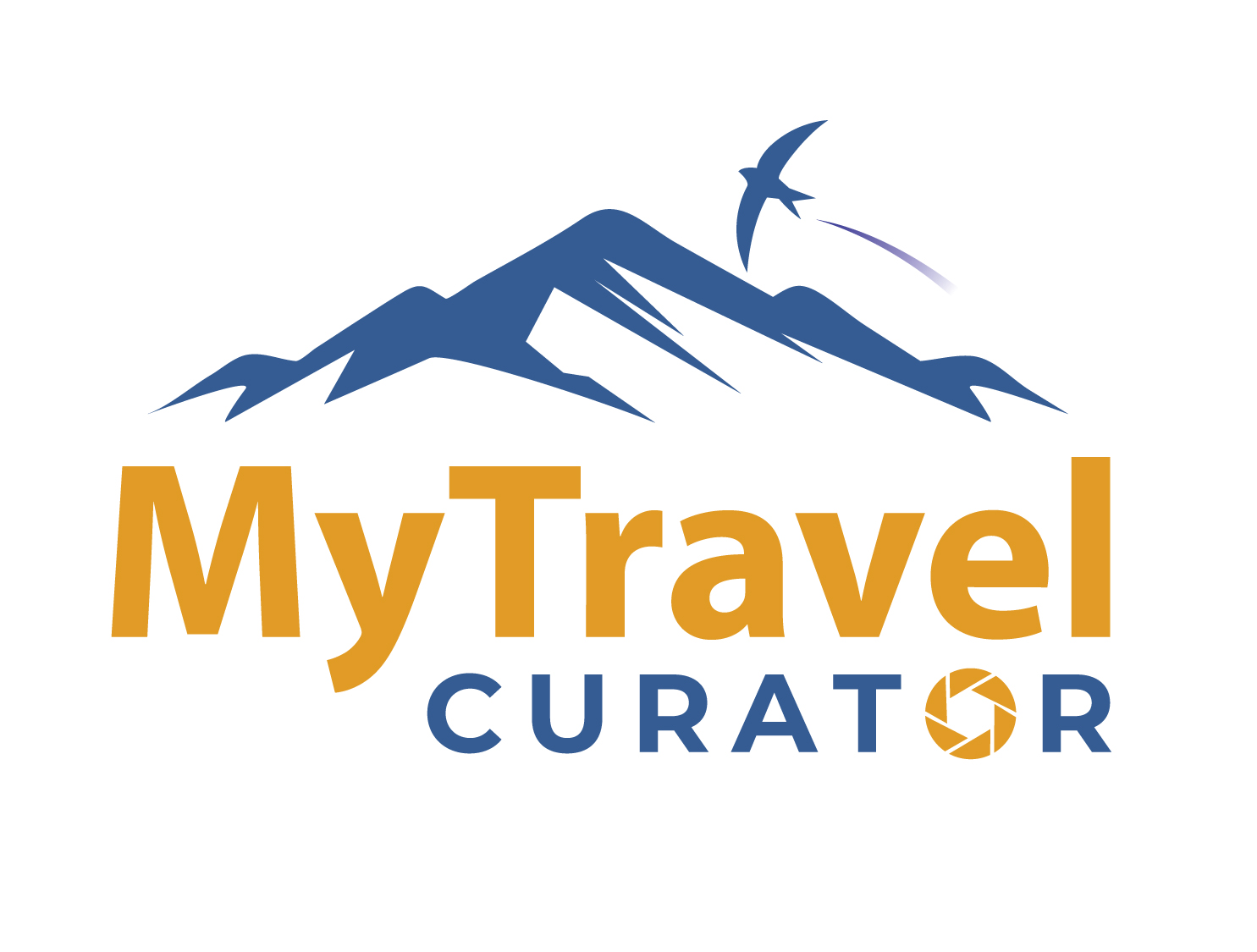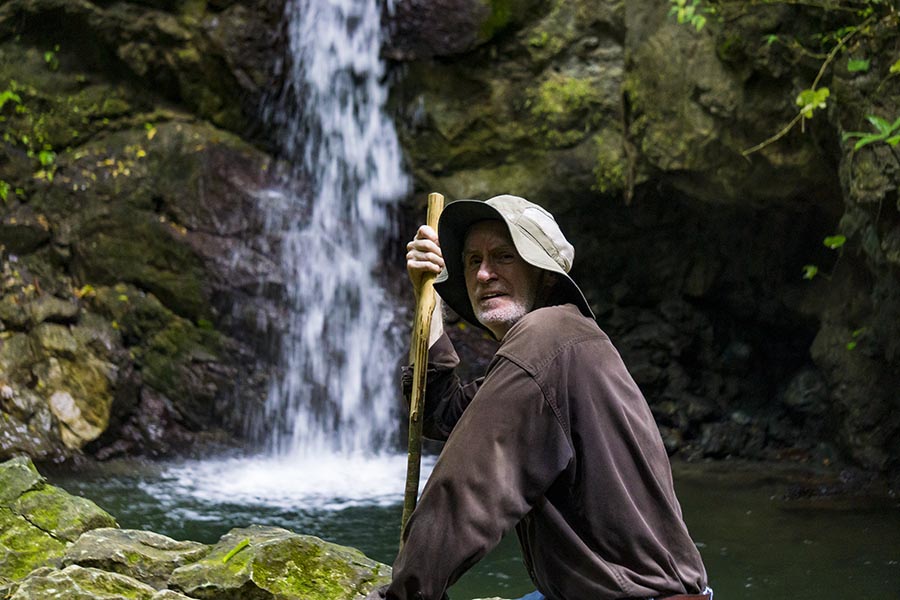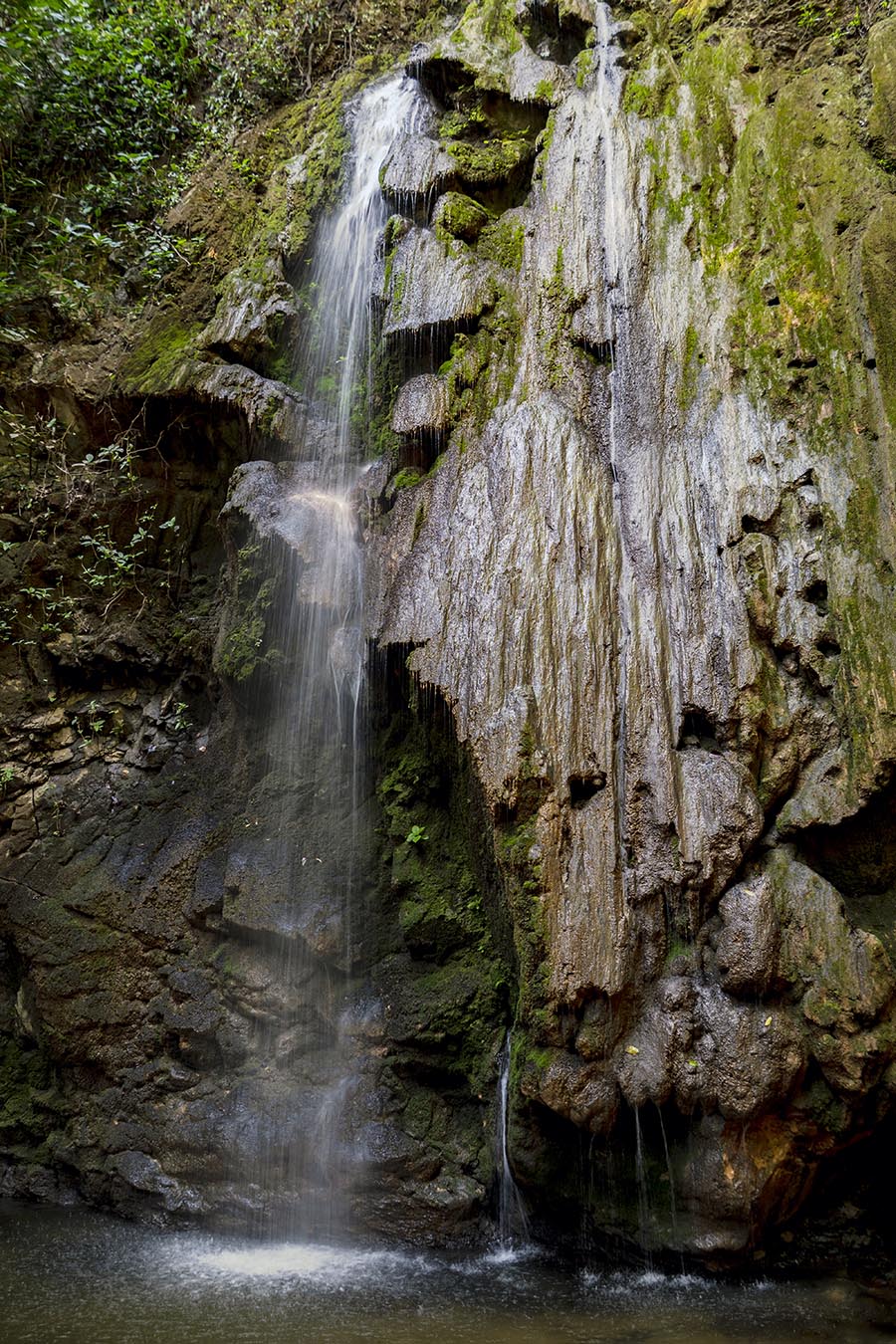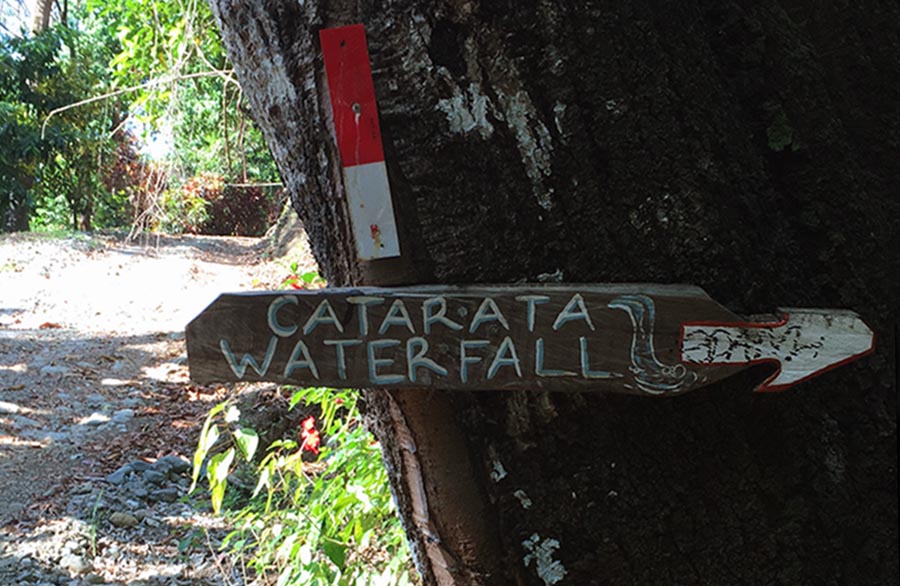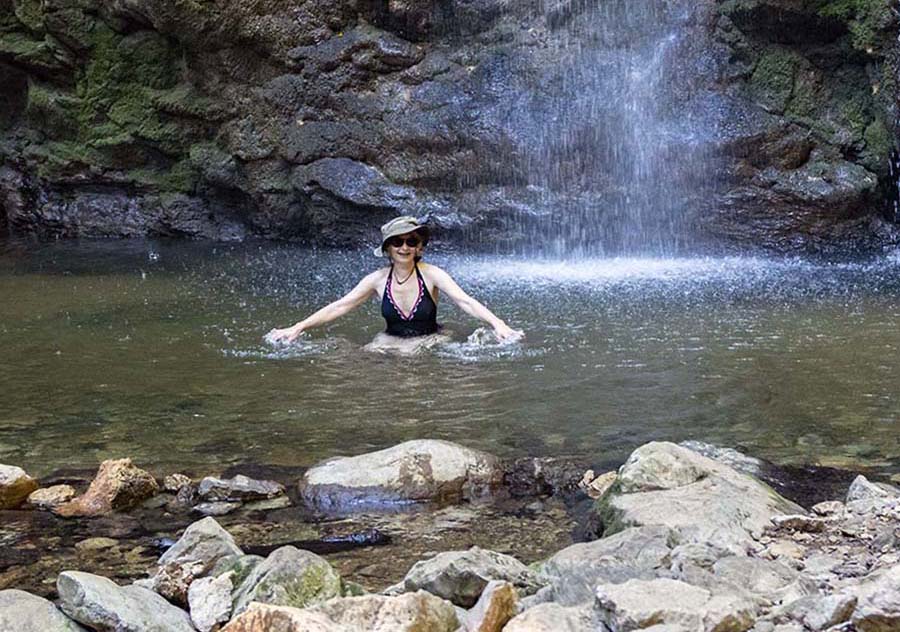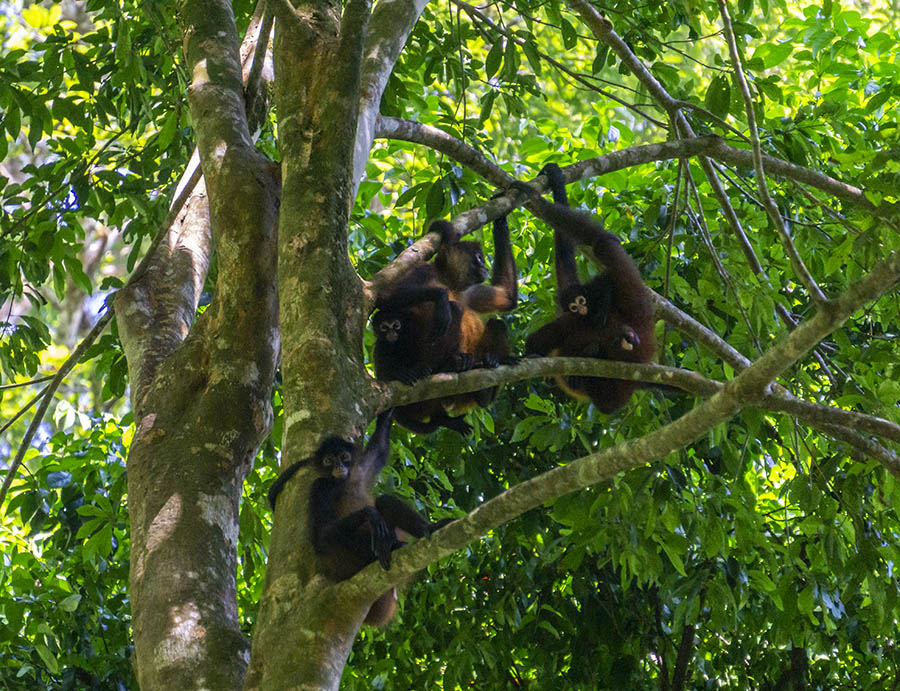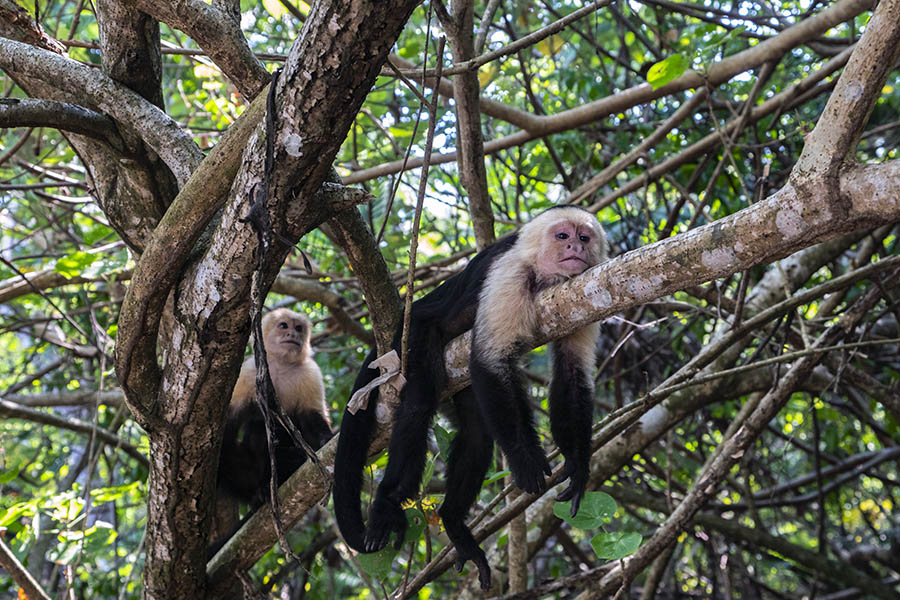The King Louis Waterfall, just off the Matapalo Beach Road is a hidden gem on Osa Peninsula in Costa Rica. One does not have to be exceptionally fit or daring to visit it, but some planning is required to make this trip a success. Read on to learn about the place, when to go and how to find it.
King Louis Waterfall Info
- Height: about 100 ft (watch one min atmospheric slow-motion video clip of the waterfall)
- Habitat: Primary growth lowland rainforest
- Entrance fee: free
- Effort level: Moderate to somewhat Strenuous (not recommended for small children)
Time Required:
Depending on whether you are staying in Matapalo or coming from Puerto Jimenez, plan to spend 4 to 5.5 hours total (perfect as a half-a-day trip):
- 3 hours (with 30 min climb each way) for the waterfall visit itself
- 1 hour (30 min each way) to walk along Matapalo Beach Road
- 1.5 hour (40-45 min each way) to get to Matapalo Beach Road (if you start your trip from Puerto Jimenez)
- Best Time to Visit: starting early in the morning (around 7 am) is absolutely the best time to enjoy the solitude (before “the crowd” arrives), to have a better opportunity for wildlife watching, and to enjoy cooler temperatures
What to Bring:
- Water and food (there are NO shops or restaurants in the area)
- Hiking boots or comfortable non-slip sneakers (avoid flip-flops, sandals etc., we have seen tourists turning around half-way into the climb, because they did not have proper shoes to complete the hike all the way to the waterfall)
- Binoculars and/or camera with a long-lens for wildlife viewing
- Beach towels and swimwear for refreshing dips in waterfall pool, cascades and at nearby beaches.
How to get there:
- Drive or take a bus/taxi to the Matapalo Beach Road if you start in Puerto Jimenez
- Our advice: Do not drive on the Matapalo Beach Road! and take a pleasant 30-min walk (about 1 mile) instead
- At the very end of this dirt road by the beach, look for a short offshoot in the right and the “Catarata” sign (Spanish for “Waterfall”) on a tree trunk (see the blog picture above and follow the details further below). This is the head of the King Louis Waterfall trail
- Follow a poorly marked trail along the stream (we counted ONLY a handful of those “red-and-white” tags like the one attached next the “Catarata” sign) as you climb up all the way to the waterfall
Matapalo Beach Road to the Waterfall Trail
As I mentioned above, driving along the Matapalo Beach Road is not recommended, unless you have an ATV or a car with a VERY good clearance (simply having a standard 4×4 car is not enough). The road is riddled with deep potholes and littered with large rocks. Just be sure not to block any traffic (the local property owners, staff and some vacationers do take their pick-up trucks, dirt bikes and ATVs through there).
You can park your car by Playa Pan Dolce (the first beach off Matapalo Beach Rd.) as you leave the main road leading to the Carate Gate of the Corcovado National Park. If you do decide to drive on, but change your mind, you may also park your car by the Playa Carbonera down the road and walk the remaining distance. This is something we did after we realized the road was in a very poor condition.
If you set out in the morning, your walk will be mostly in the shade (until the very last few hundred feet). During this early hour, you might have your first wildlife-watching opportunities of the day. Spotting interesting birds is easy around here. On our walk along the Matapalo Beach road, we passed several small guided bird watching parties scouting the dense vegetation with their Swarovski scopes and binoculars.
Along the way, you will see occasional small lodges and private vacation homes.
Finding and Climbing the King Louis Waterfall Trail
Towards the end of the road, you will also be able to see the beach through the vegetation on your left. As the road starts curving sharply to the left, there is a smaller less-traveled “offshoot” on your right. Follow it for another hundred feet till you see a big tree with “Catarata” sign and an arrow attached to its trunk. If the road ended and you are facing the beach, you’ve walked a hundred feet too far.
Just as it is tricky to find the trail start, it is hard to know for sure where exactly the trail goes after you start your climb. If you begin early, you likely won’t see anyone there to show you the way. However, the rocky passage is rather narrow, and it is hard to get lost. One short section of the trail is equipped with a guide rope.
We did not meet a sole on the way up (while seeing at least 10 people on the way back). As you continue pushing forward, there will be a couple of smaller cascades on route to take a dip and cool down.
Swimming and Waterfall Rappelling
After a half-an-hour climb, we’ve finally reached the waterfall! It was the tallest waterfall we’ve seen in Southern Costa Rica so far. Surrounded by the massive mossy rocks and towering rainforest trees, we spent a couple of hours swimming, reading and enjoying the solitude.
If you are looking for even more adventure and a jolt of adrenaline, you may wish to look into other options to visit the King Louis Waterfall. Some local lodges in Matapalo and tour operators in Puerto Jimenez will offer you both tree-climbing and waterfall rappelling tours in the area.Check out this blog post for a vivid narrative about such a adventure.
Viewing Spider Monkeys by the Waterfall
Wildlife sightings is something one can hope for but can never be guaranteed. However, the remote location and proximity to the Corcovado National Park makes King Louis Waterfall area a perfect place for such rare encounters.
After we settled and quieted down by the “pool”, I suddenly spotted a couple of larger monkeys moving briskly through the canopy. A moment later, two more monkeys joined them in the same tree. Since we did bring our binoculars on this hike, I was happy to have my long camera lens as a substitute.
This was our first sighting of a Spider monkeys in Costa Rica (the second one was a rather brief encounter a few days later along the private Osa trail of the Lapa Rios Ecolodge). It was 2 female monkeys, each having a tiny white-faced baby clinging to their mothers.
There was also a younger adult, who was bouncing back and forth between “socializing” with the females (one of which was probably his mother) and carefully exploring the surroundings nearby on his own. The entire time, they seemed to ignore our presence and it was hard to take our eyes off this entertaining family scene.
The patch of the rainforest around the waterfall is a prime natural habitat for Spider monkey, who are frugivores and need to roam large areas with tall primary-growth trees and plenty of fruits to survive. Since this type of primary rainforest remains scarce, Spider monkey is currently one of the most endangered primate species in Costa Rica and Central America.
We Will Be Back
All in all, this hike to the King Louis Waterfall was definitely one of the highlights on our trip to the Osa Peninsula. We would highly recommend it to nature lovers and adventure-seekers alike. While many Costa Rican waterfalls are slowly turning into crowded “tourist traps”, this one remains a pristine and quiet place. This also one of very few hiking opportunities in Matapalo with public access. Most hiking trails in this area are privately owned and their use would require special arrangements.
Enjoy Pristine Matapalo Beaches and More Wildlife
But wait, there is more. You might consider extending your Waterfall trip by visiting one or more of the nearby beaches on the way back. And not necessarily only for swimming and sun worshiping. You can follow the beach along the Matapalo Beach Road all the way back to the main road. Or you can combine walking in the shade with spending sometime on each of the gorgeous beaches.
On our way from the waterfall, while exploring the Carbonera Beach (halfway between the waterfall trail and the main road), we ran into a troupe of well over a dozen of White-faced Capuchin monkeys. We spent the next 45 minutes watching these highly social and dexterous foragers doing “their normal thing” in the bush.
In truth, we were not sure, who was watching who during that thrilling encounter. It started a little “stand-off-ish”, as the alpha male approached us rather closely, while flashing his teeth. However, after a few tense minutes of “measuring up to his competition”, he plumped down on a nearby branch and assumed a rather relaxed napping posture (watch a 1 min video of this guy). Seemingly relieved, his entire following proceeded by going about their own business as well.
Despite all that grooming, eating and quarreling, they clearly kept an eye on us and what “we were up to” at every given moment. As I learned later from several reads on the subject, Capuchin Monkeys are often attracted by any “activities” on their territory. They are notorious for frequently “stalking” people and many other animal species. To learn more about the White-faced Capuchins and the other three species of monkeys we met during our week-long stay in Matapalo, read my post “Find all Costa Rican Monkey Species in One Place”
